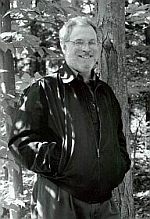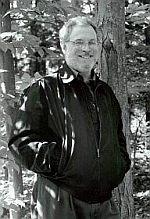
A concert that features only one composer is a fascinating opportunity, not only to get a thorough picture of that composer’s style, but also to track changes in it over time. San Francisco State University’s 60th birthday retrospective of Richard Festinger presented what, to me, seemed like two different approaches to music — yet still in the same basic style. I later noticed that the two perceived methods came from two different time periods: one from the 1990s, the other from last few years.
A Serenade for Six (for “Pierrot ensemble” and percussion, 1993) and Peripeteia (for clarinet, violin, and cello, 1999) both belong to what I consider the mainstream late-20th-century “modern” style of chamber music. A clarinet frill of 13 or so quick notes followed by a forte-piano, dissonant long note; a low-register cluster; another brief shriek throwing together random quick notes, deliberately not in a key; an off-beat, clipped Bartók pizzicato or two; a ponticello murmur answered by a trill; detached tremolos passed around. Repeat and vary until bored, carefully avoiding tonality but remembering to claim that it is still “tonal.”
It is possible to enjoy this type of music by closing your eyes, following the interesting interactions of musical shapes and colors, and sensing the abstract audio drama that unfolds. This requires heavy concentration, patience, and a very open mind; it is not particularly audience-friendly stuff. The other three pieces on the program were in a different vein.
Exploring Textures, Rhythms, and Natural Sounds
Festinger’s String Quartet No. 2 (From the Beginning, from 2005), Insect Voices (2008), and Legerdemain (2008) were all more attention-grabbing, more coherent, easier to follow. From the Beginning, compellingly performed by the young Afiara Quartet, progresses captivatingly from ethereal desolation to swarming excitement. In Legerdemain, common understanding of rhythm is thrown into question, hovering at a tantalizing boundary between groovy and pulse-free. Daniel Kennedy handled the improvised setup of bongos, dumbeks, and a frame drum like a six-armed Indian god, commanding the instruments with precision and power.
Insect Voices, for soprano, flute, violin, cello, percussion, and recorded sound, features sound samples of insect chirps amplified to the cusp of dangerous ear pain. Soprano Alissa Deeter approached that hazardous sound level herself with her powerful shrieks. The accompanying instruments imitated the insects’ sounds with surprisingly literal accuracy. It was a fun, interesting, and at times moving reflection on those highly musical natural sounds, combined with apt poetry selections from the United States and the Far East.
In these three more recent pieces, Festinger retains his almost tonal harmonic language and his wide array of timbral tools, but the construction and message of the works is slightly less abstract, less cognitive and academic, more relevant. For me, the slight shift in approach made a world of difference — the newer works were easier to enjoy and understand on a variety of different levels.
The Perils of Periodicization
What do composers think when listeners divide their music up into stylistic periods and generalize about their own newly created categories? (What would Beethoven have thought of our periodicization of Beethoven? What does Elliott Carter, for that matter, think of our periodicization of Carter?) Maybe Festinger, reading the above, is shaking his head in disbelief at my bizarre, way-off interpretations; maybe he’s nodding “right on”; perhaps he’s appreciating an insight my honest reactions have given him into his own musical tendencies.
The concert would not have been possible without earnest performances from the Adorno Ensemble, the Afiara String Quartet, and members of SFSU’s faculty. The Adorno Ensemble, serious yet passionate, sounded as if the players loved the music and knew it intimately. The Afiaras, in their last weekend as SFSU’s quartet in residence (and on their way to Banff), have a remarkably unified sound and show great promise as a young ensemble. Cyrus Ginwalla conducted with strength and precision.
This concert was a part of San Francisco State University’s two-day First Annual Illuminations and Reflections: Symposium on Music in the 21st Century. The conference, ostensibly about music from the 2000s, devoted almost half of its time to men born in 1909 (Carter and Messiaen, the latter of whom died well before this century began). But there was also an Emerging Composers Concert, presenting works of seven composers under 40, as well as paper presentations and panel discussions on American music, politics and music, and the concert hall in the digital age. Let’s hope that this annual symposium is the first of many.

